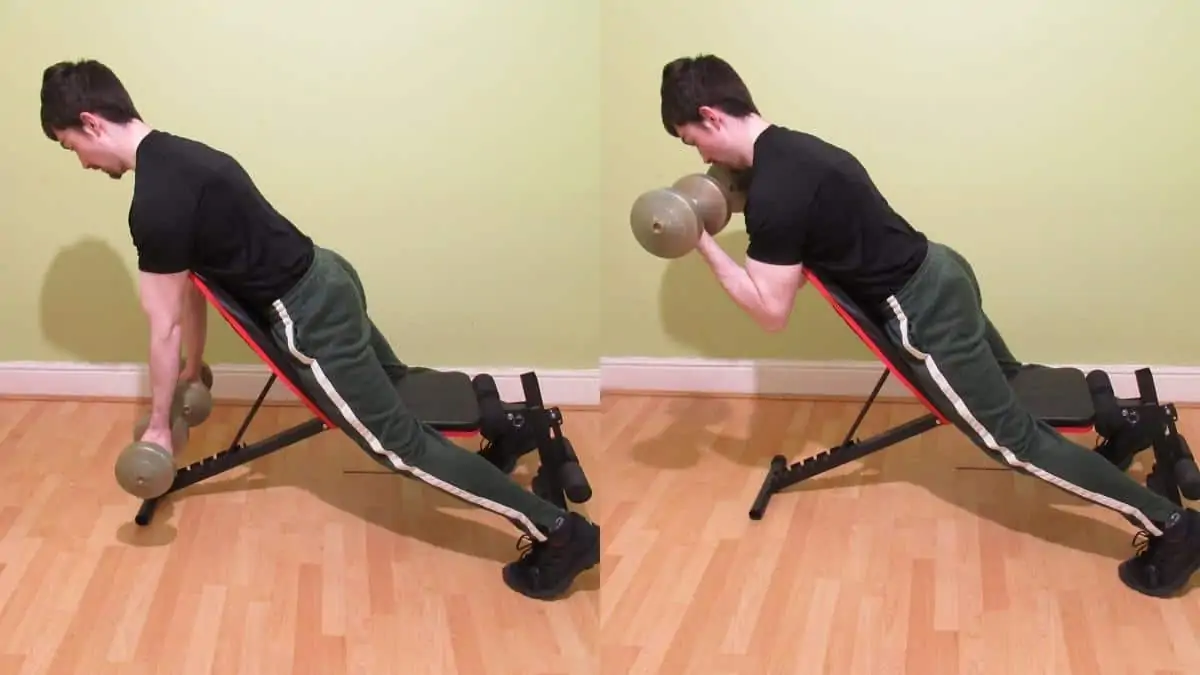Spider curls are a remarkable exercise for building the biceps because they produce an intense muscle contraction on every single rep. Similarly, the dumbbell spider curl is one of the most effective bodybuilding bicep exercises because the stability of the incline bench makes it difficult to cheat the weight up. As such, the vast majority of the tension stays on the target area, which results in greater muscle growth.
This tutorial explains how to do the DB spider curl with the proper form. We’ll then discuss the training tips that will help you to get the most from this movement, as well as the other exercise variations that you can do for your biceps. Finally, we’ll finish with some FAQs.
Related: Short head bicep workout
Dumbbell spider curl exercise details
- Main Muscles: Biceps brachii
- Secondary Muscles: Brachioradialis, brachialis, forearm flexors
- Exercise Type: Strength
- Exercise Mechanics: Isolation
- Difficulty Level: Beginner
- Equipment Needed: Incline bench, dumbbells
How to do dumbbell spider curls correctly
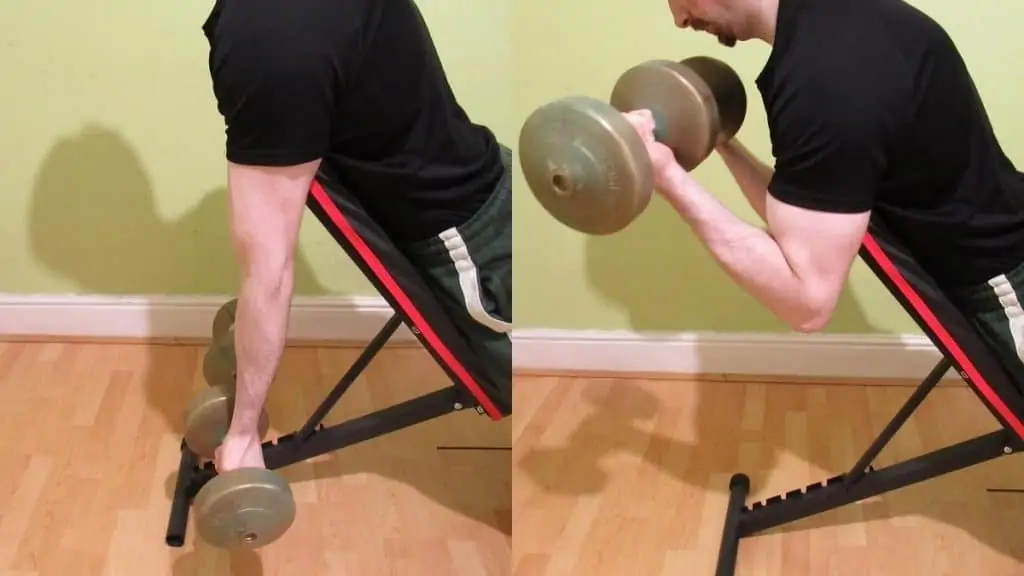
- Set the backrest of an incline bench to a 60-degree angle.
- Grab two moderately light dumbbells with an underhand grip.
- Sit on the bench in a reverse position with your chest pressed into the backrest.
- Let your arms hang in front of your torso.
- Curl the dumbbells toward your shoulders and squeeze your biceps forcefully.
- Hold the contraction for a moment, and then lower the weights under control until your elbows are fully extended.
- Repeat for 3-5 sets of 10-15 reps.
Spider curl training tips
Now that you know how to lift with the proper spider curl form, it’s time to explore the training tips that will help you to get the best results from this popular exercise.
Supinate your wrists
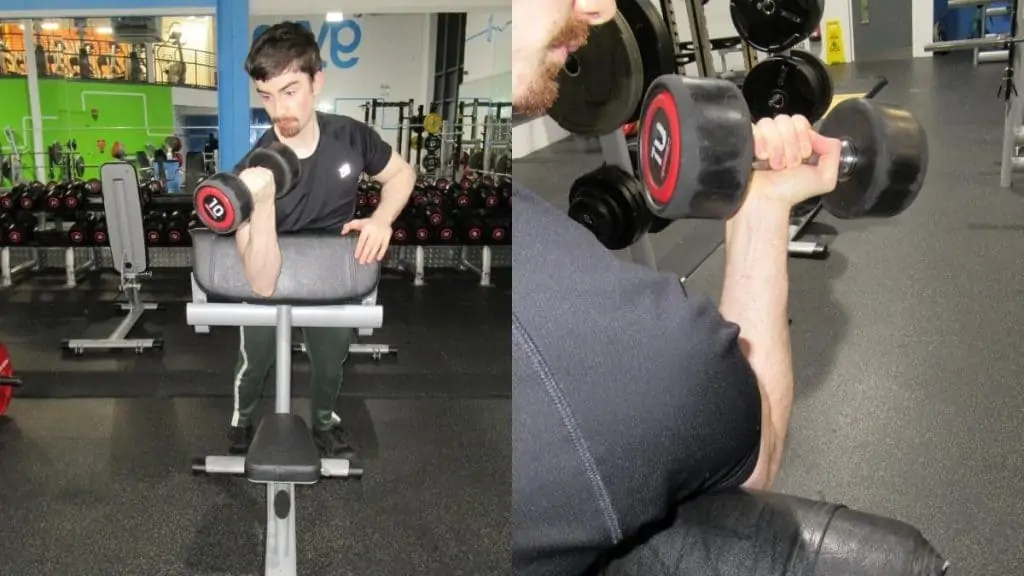
Most people already perform incline bench spider curls and their other free weight biceps exercises with supinated wrists, hence why this exercise is renowned for producing an intense muscle contraction.
However, by actively supinating your wrists at the top of every rep, you can take the effectiveness of this exercise to the next level.
Aim to hold the dumbbell on the outside of the handle so that the end of the weight is touching your thumb. Then, as you curl the dumbbell, think about turning your pinky fingers away from your body. This grip will force you to use more of your bicep muscle fibers in order to lift the weight, which in turn will result in a much stronger peak contraction.
While this grip might mean decreasing the resistance slightly until you master the form, just remember that increasing the tension placed on a muscle (which is what we’re doing here) is a form of progressive overload. So even though you might not be lifting any more weight, your biceps will most definitely be doing a lot more work.
Focus on the contraction
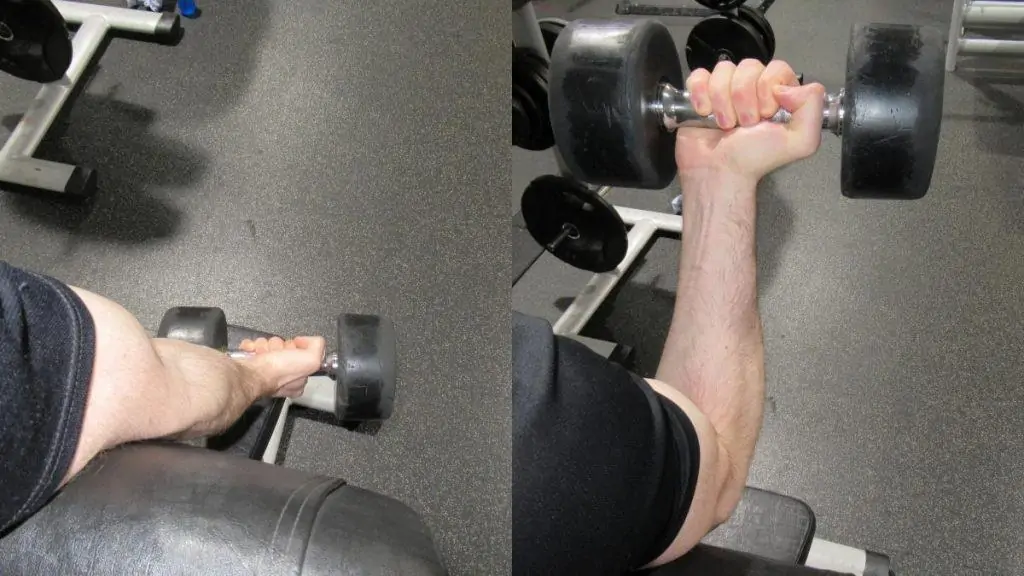
DB spider curls are most difficult at the top of the rep when your biceps are maximally contracted. So naturally, this is also the part of the lifting motion that generates the most muscle tension.
Therefore, it’s crucial to focus on the contraction if you want to maximize your bicep development.
Try to squeeze your biceps as hard as you can for a full second at the top of every rep. Not only will this practice produce a more powerful muscle pump, but it’ll also make your biceps stronger because, as mentioned, the shortened muscle position (i.e., the contraction) is always the most challenging part of a spider dumbbell curl.
As such, the rest of the rep will feel easy when you become proficient at flexing your biceps at the top of the rep. This strength, in turn, will enable you to lift heavier weights and thus overload your biceps with more resistance, which will result in greater hypertrophy if your diet and recovery are good.
Get a full range of motion
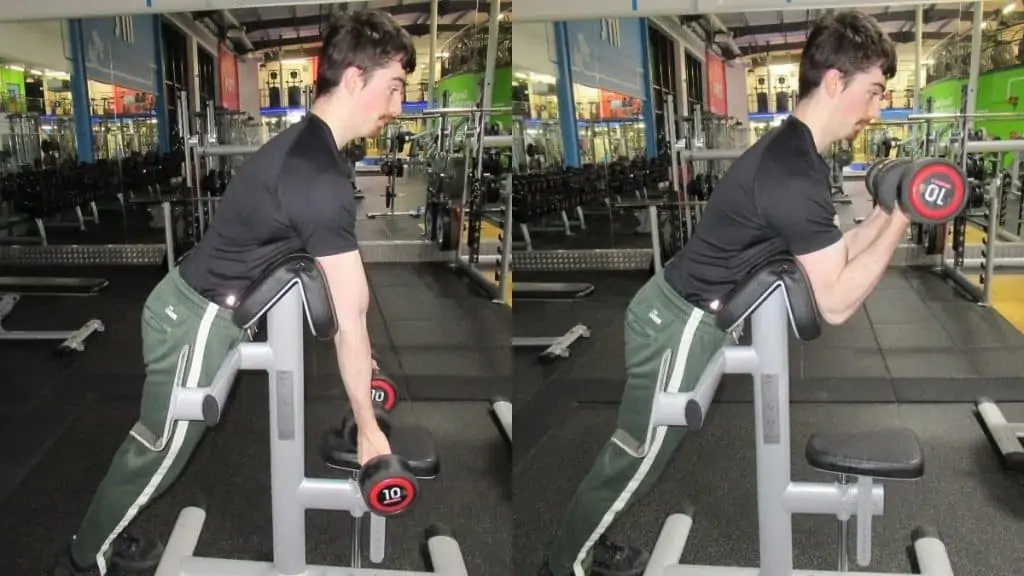
Although the contraction is undeniably the most crucial part of incline spider curls, that fact doesn’t mean that you should perform half reps. Instead, lower the weights all the way down until your elbows are locked out. You can even flex your triceps at the bottom of the rep to ensure that your biceps are fully lengthened. [1]
You might think that you’re taking tension off the muscle by extending your elbows—and you’d be quite right. However, taking tension off your biceps for a split second will not come close to limiting your gains. If anything, using full reps will lead to more muscle growth because you’ll be recruiting a broader range of muscle fibers that you wouldn’t be able to stimulate with half reps.
This also applies when you’re trying to build your back and bis because pulling movements require a large range of motion in order to be effective.
Spider curl variations
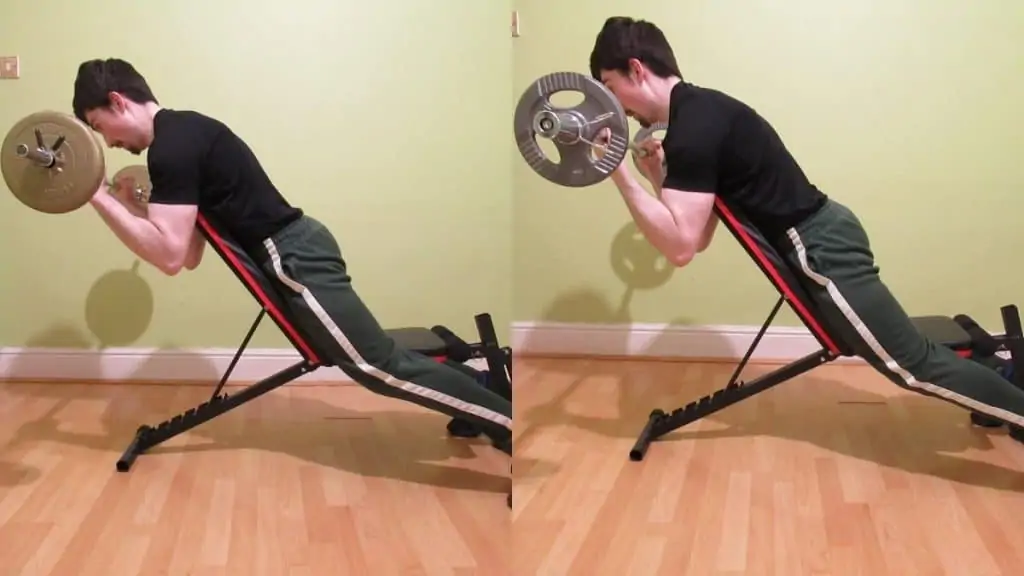
There are many variations of the spider curls exercise (and countless other types of bicep curls) that you can perform to build your biceps. Not only can you perform spider curls with different equipment, but you can also do them on different equipment and in various positions, which is what this section is all about.
- Spider hammer curls
- Barbell spider curl
- EZ bar spider curl
- Reverse spider curls
- Cable spider curls
- Kettlebell spider curls
- Resistance band spider curls
- Single arm spider curls
Spider curls on an incline bench
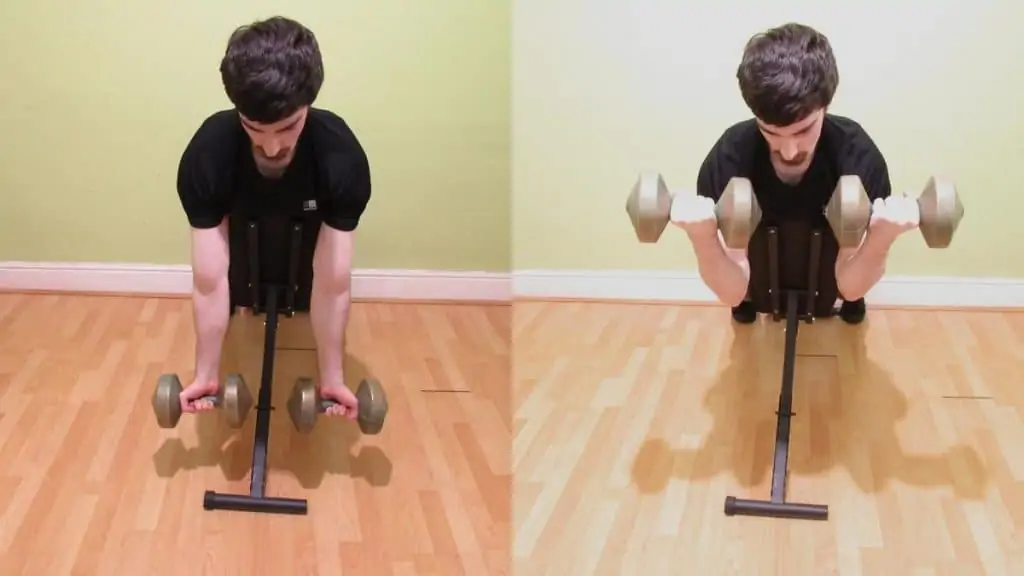
It’s entirely possible to do a spider curl without a preacher bench. All you need is an adjustable bench, a pair of dumbbells, and a tolerance for bicep lactic acid.
From there, you want to set the backrest of the bench to between 45 and 60 degrees. Then, you simply sit on the bench with your chest pressed against the backrest and let your arms hang in front of you.
Next, curl the weights toward your shoulders and squeeze your biceps as hard as you can, making sure to twist your little fingers away from your body as you contract your biceps. Finish the rep by lowering the dumbbells under control until your elbows are extended.
Spider curls on a preacher bench
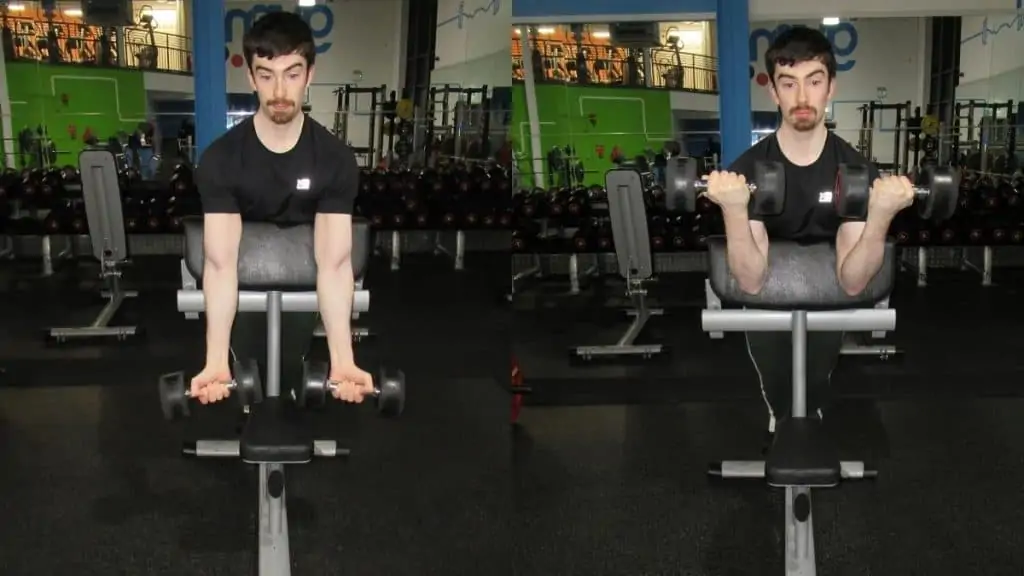
Although there’s no such thing as a dedicated spider curl bench, the vertical side of a preacher pad certainly seems like a match made in heaven for this exercise. The benefit of using a preacher bench rather than an incline bench is that it’s harder to swing the dumbbells up when your upper arms are stabilized against the pad. This makes it easier to maintain the proper lifting form.
On the other hand, when you use an incline bench, you can’t use your legs or back to cheat the weight up, but you can with a preacher bench. So the best type of spider curl for you really comes down to your equipment availability and your penchant for using other muscles to lift the weight.
Just make sure that you’re also doing some kind of bicep long head workout where you’re curling with your arms slightly behind your body so that you can work both heads of the biceps optimally.
Bent over spider curls
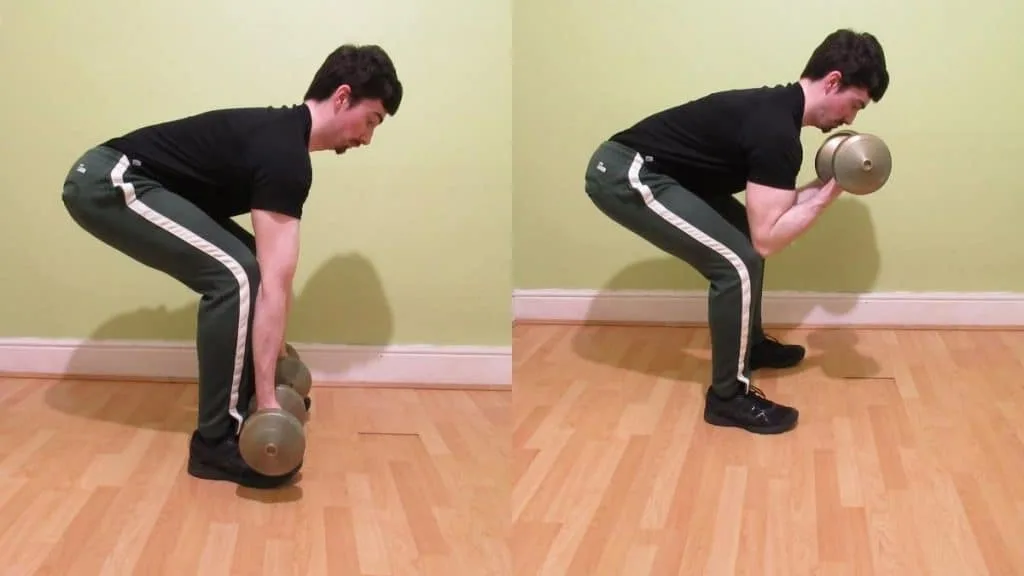
You can still do the DB spider curl even if you don’t have any equipment besides weights, which is ideal if you train at home. As such, they’re an excellent addition to a dumbbell bicep circuit because you can perform different exercises with the same pair of weights.
Begin by holding two dumbbells with an underhand grip. Then bend over at your waist so that your back is flat. Next, brace your elbows against your knees; this creates a similar angle and feeling to a regular spider curl. From there, just curl the weights up as you usually would and flex your biceps forcefully at the top of the rep.
Another spider curl alternative for those who train at home is what you might term a sofa curl. Essentially, you lie on the sofa, stomach down, dumbbells in hand, and then brace your arms against the side of the couch. Then, all you do is lift the weights, contract your biceps, and then lower them down again for a full stretch.
See Also: Spider curl vs preacher curl
Spider curl FAQ
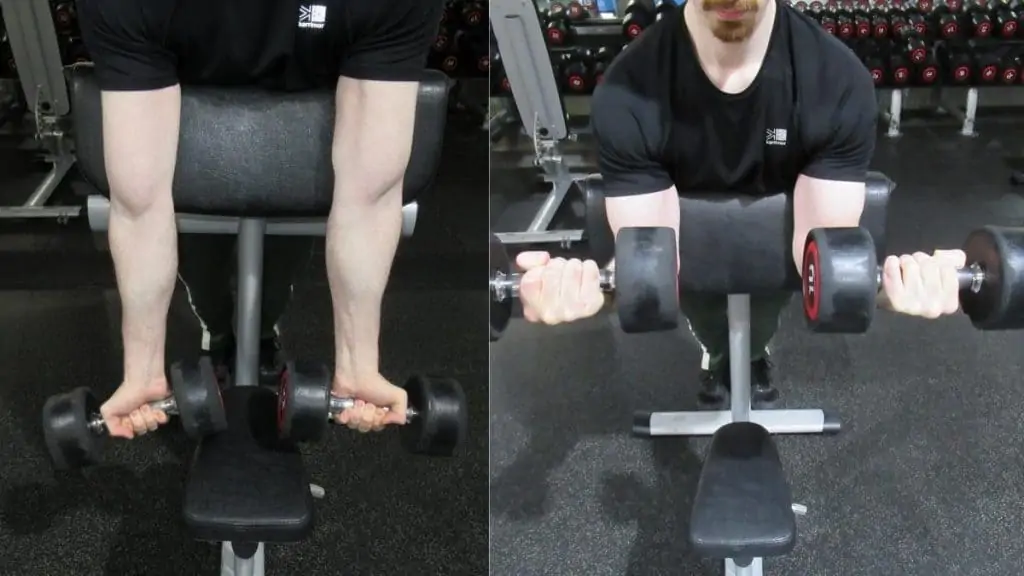
What are spider curls?
Spider curls are a bicep isolation exercise that you perform on either a preacher or incline bench. The easiest way to do them is with dumbbells; however, you can also use any other equipment that you can hold in your hands.
What muscles do spider curls work?
Spider curls mainly worth the biceps brachii because they train elbow flexion and forearm supination simultaneously, which are the two primary functions of the biceps. [2] The spider curl also works the brachialis, brachioradialis, and forearm flexor muscles.
Can you do spider curls from home?
Yes, you can do spider curls at home in the bent over position or by using the side of your sofa as a spider curl bench.
What’s the ideal bench angle for spider curls?
The ideal bench angle for spider curls is between 45 and 60 degrees. Try both positions and see which one allows you to achieve the best workout.
What are the benefits of spider curls?
The benefits of spider curls are numerous. Increased bicep size (hypertrophy) is the first and most obvious benefit that you can expect to enjoy if you perform this exercise on a regular basis.
Dumbbell spider curls also make your biceps stronger and more vascular. They also provide superior muscle isolation to traditional bicep drills because the bench makes it difficult to cheat the weight up.
Are spider curls good for building mass?
Yes, spider curls are great for building mass. Even though they require you to lift lighter than on DB curls, your biceps are still getting put under a significant amount of tension. The most important thing to remember is to focus on the contraction since this the most challenging part of a spider curl repetition and thus the portion of the rep that builds the most mass.
Why do I get chest cramp from spider curls?
Some lifers experience chest cramp from spider curls because the bench is pressed against their sternum. If you feel this uncomfortable cramp, then you should switch exercises. If the problem persists, then make sure to talk to a medical professional to rule out something more serious.
Read More: Drag curls vs spider curls │Superset for the biceps
Conclusion: Are spider curls a worthwhile exercise?
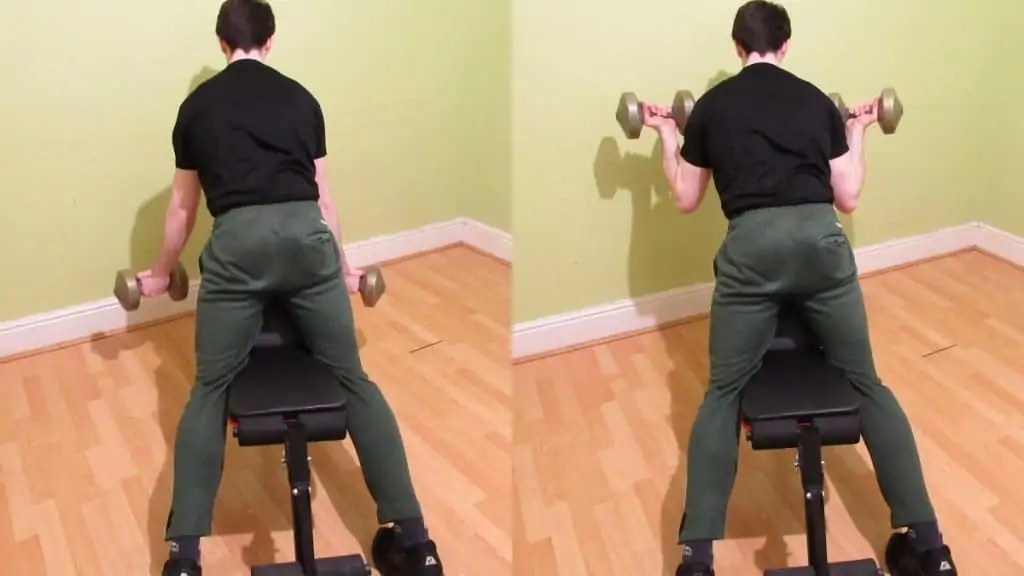
The dumbbell spider curl is definitely worth your while if you’re in pursuit of bigger and better biceps. Unlike other exercises, the DB spider curl really lets you hone in on the target muscles because the bench stabilizes your upper and lower body, which makes it hard to cheat the weight up.
Make sure to focus on the contraction if you want to get the most from your spider curls. While it’s essential to get a full range of motion by lowering the weight all the way down, the contracted position is where your biceps have to do the most work. So be sure to squeeze those arms as you curl the dumbbells toward your front delts.
You’ll generally want to use higher reps on dumbbell spider curls because the biceps are weaker when they’re fully shortened (i.e., contracted). So stick to sets of 10-15 reps to get the best results.
References
- Biology Online. (2021, April 2). Antagonistic Muscle Definition and Examples – Biology Online Dictionary. Biology Articles, Tutorials & Dictionary Online. https://www.biologyonline.com/dictionary/antagonistic-muscle
- Picture of the Biceps. (2012, February 17). WebMD. https://www.webmd.com/fitness-exercise/picture-of-the-biceps

